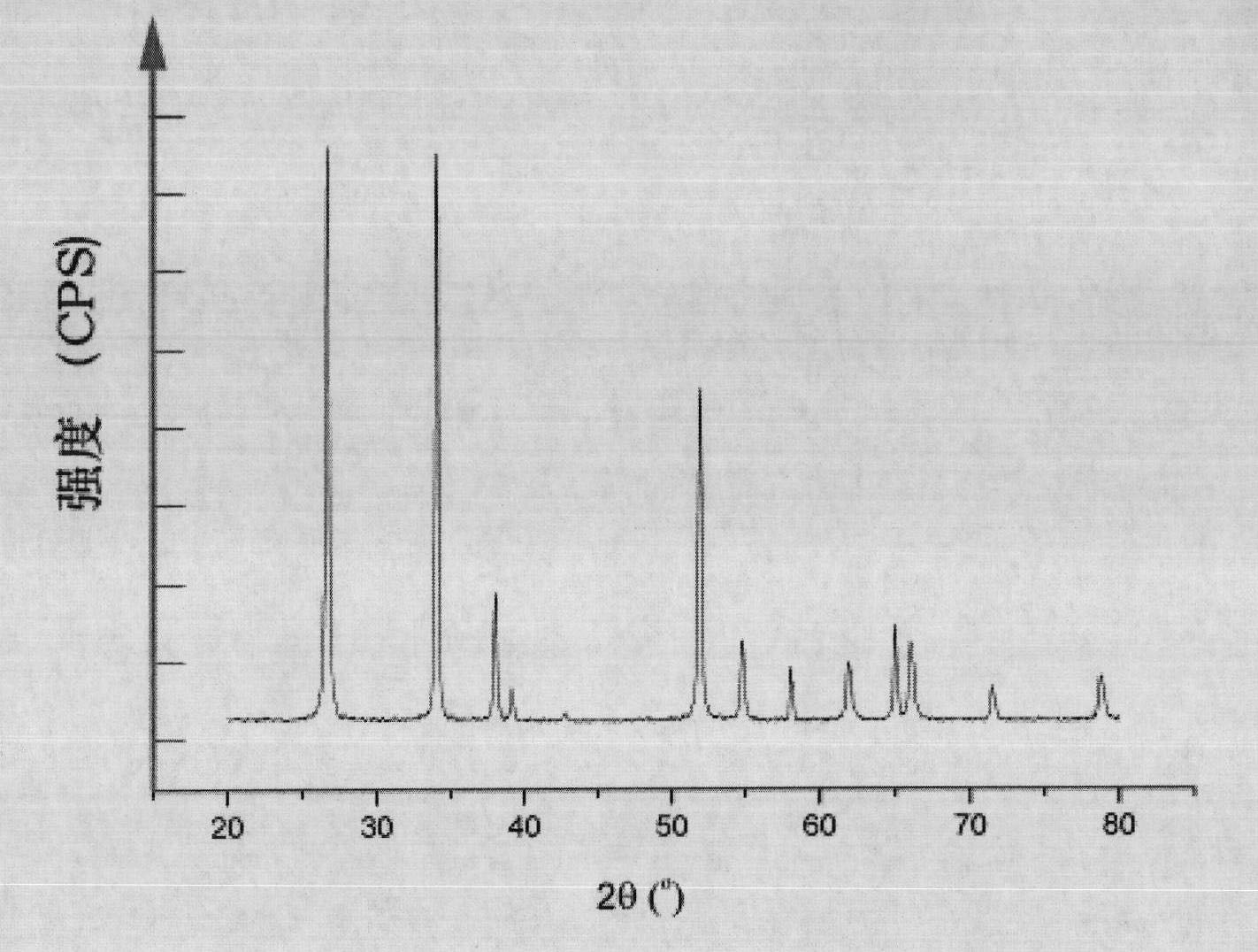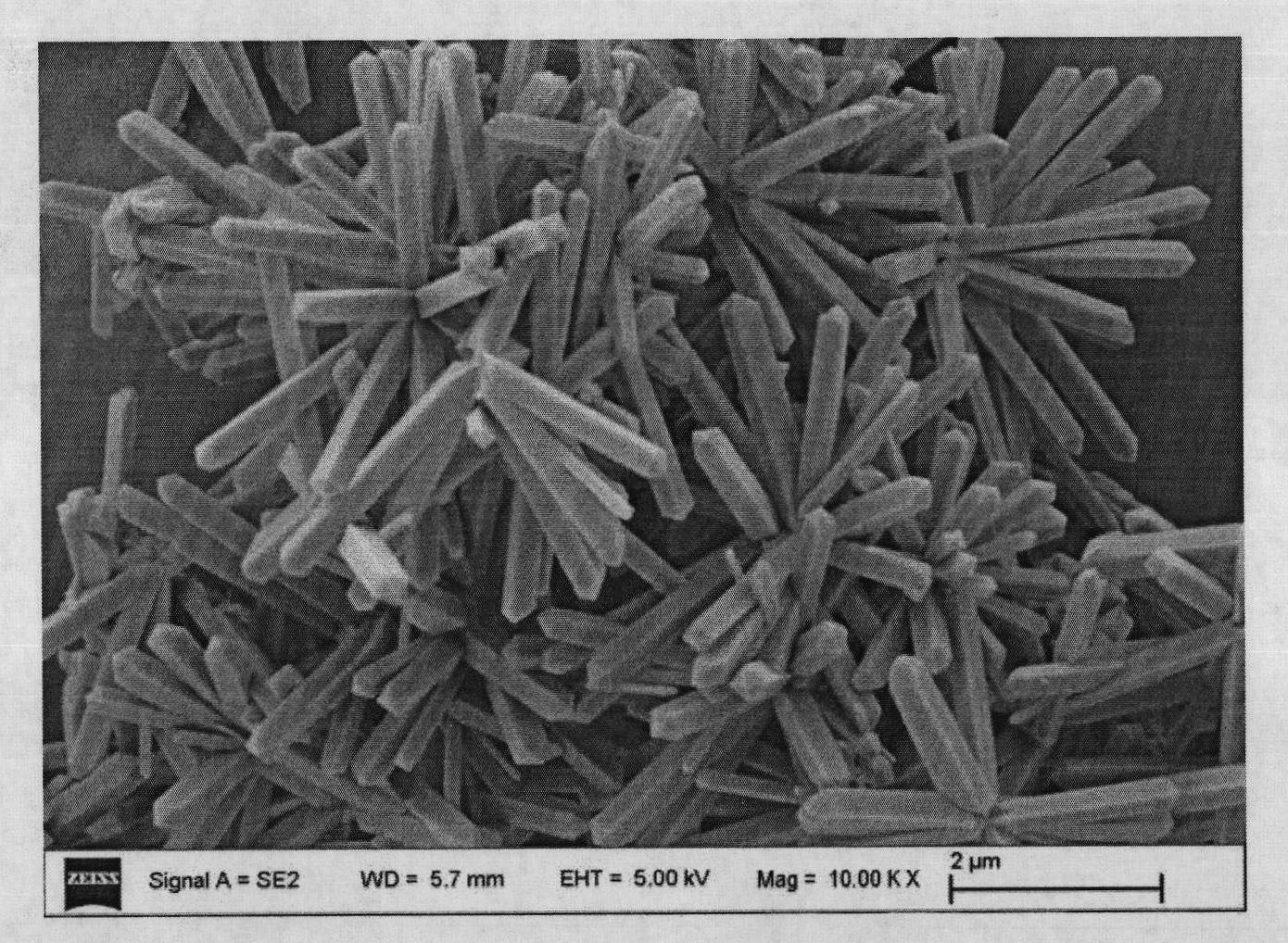Tin oxide nanomaterial and preparation method thereof
A nanomaterial, tin oxide technology, applied in tin oxide and other directions, can solve the problems of gas-sensing materials to be improved, low crystallinity, etc., and achieve the effects of high crystallinity, high product yield, and easy industrialization.
- Summary
- Abstract
- Description
- Claims
- Application Information
AI Technical Summary
Problems solved by technology
Method used
Image
Examples
Embodiment 1
[0028] A. prepare the tin chloride solution of 0.05mol / L with deionized water;
[0029] B. Sodium hydroxide is dissolved in deionized water to prepare the alkali solution of 4mol / L;
[0030] C. Under stirring, slowly add the alkali solution prepared in step B dropwise to the tin chloride solution prepared in step A until the molar ratio of tin ions and hydroxide ions in the solution is 1:8, then press the mixed solution volume Weigh an equal volume of absolute ethanol and mix it with the reaction solution, and disperse it with magnetic stirring for 5 minutes; transfer the dispersed reaction solution to a hydrothermal kettle, raise the temperature to 240°C, react at constant temperature for 30 hours, and cool naturally to room temperature. The product was filtered, washed with deionized water for 5 times, and then washed with absolute ethanol for 5 times, and then dried naturally to obtain a one-dimensional tin oxide nanomaterial with good crystallinity.
[0031] The results o...
Embodiment 2
[0033] A. prepare the tin chloride solution of 0.15mol / L with deionized water;
[0034] B. Sodium hydroxide is dissolved in deionized water to prepare an alkaline solution of 6mol / L;
[0035] C. Under stirring, slowly add the alkali solution prepared in step B into the tin chloride solution prepared in step A until the molar ratio of tin ions and hydroxide ions in the solution is 1:10, and then press the mixed solution volume Weigh an equal volume of absolute ethanol and mix it with the reaction solution, and disperse it with magnetic stirring for 5 minutes; transfer the dispersed reaction solution to a hydrothermal kettle, raise the temperature to 200°C, react at constant temperature for 40 hours, and cool naturally to room temperature. The product was filtered, washed with deionized water for 5 times, and then washed with absolute ethanol for 5 times, and then dried naturally to obtain a one-dimensional tin oxide nanomaterial with good crystallinity.
[0036] Scanning elect...
Embodiment 3
[0038] A. prepare the tin chloride solution of 0.3mol / L with deionized water;
[0039] B. Potassium hydroxide is dissolved in the deionized water preparation 4mol / L alkaline solution;
[0040]C. Under stirring, slowly add the alkali solution prepared in step B into the tin chloride solution prepared in step A until the molar ratio of tin ions and hydroxide ions in the solution is 1:10, and then press the mixed solution volume Weigh an equal volume of absolute ethanol and mix it with the reaction solution, and disperse it with magnetic stirring for 5 minutes; transfer the dispersed reaction solution to a hydrothermal kettle, raise the temperature to 220°C, react at a constant temperature for 24 hours, and cool naturally to room temperature. The product is filtered, washed with deionized water for 3 to 5 times, washed with absolute ethanol for 5 times, and then dried naturally to obtain a one-dimensional tin oxide nanometer material with good crystallinity.
[0041] Scanning el...
PUM
| Property | Measurement | Unit |
|---|---|---|
| diameter | aaaaa | aaaaa |
| length | aaaaa | aaaaa |
| diameter | aaaaa | aaaaa |
Abstract
Description
Claims
Application Information
 Login to View More
Login to View More - R&D
- Intellectual Property
- Life Sciences
- Materials
- Tech Scout
- Unparalleled Data Quality
- Higher Quality Content
- 60% Fewer Hallucinations
Browse by: Latest US Patents, China's latest patents, Technical Efficacy Thesaurus, Application Domain, Technology Topic, Popular Technical Reports.
© 2025 PatSnap. All rights reserved.Legal|Privacy policy|Modern Slavery Act Transparency Statement|Sitemap|About US| Contact US: help@patsnap.com



